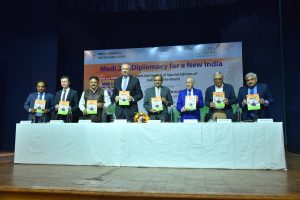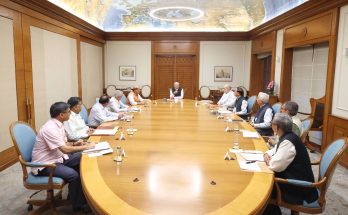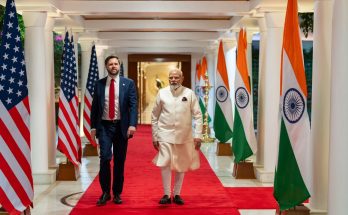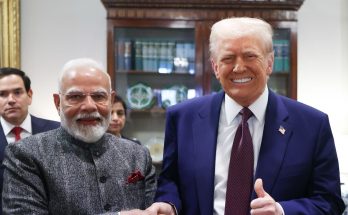
In an overarching speech delivered at the launch of the special edition of India and the World magazine, T.S. Tirumurti, Secretary in charge of economic affairs in India’s Ministry of External Affairs, outlined guiding principles of India’s Development Diplomacy, and its ramifications for shared development of the world at large.
“Let me at the outset remind this august group that even before the phrase “development diplomacy” was coined and became a conscious choice in our foreign policy, this impulse to share what we have with others has a strong civilizational underpinning,” Mr Tirumurti said at the Panel Discussion on Diplomacy for a New India, organized by India Writes Network and TGII Media, at the Teen Murti Auditorium in New Delhi on October 22.

Placing India’s development diplomacy in the larger context of its civilizational identity, Mr Tirumurti said: “India has through its history prioritized cooperation over conflict, co-existence over competition, sharing over receiving, plurality over hegemony and shared prosperity over zero-sum notions of growth. Development diplomacy was, therefore, ingrained in our national habit and civilizational identity.”

In his insightful speech, Mr Tirumurti brought out vividly the organic linkage between India’s development and the rest of the world. “Just as India’s development is good for the world as a factor for peace, prosperity and stability, we believe that the development of other countries, including our neighbours, is also good for us. This is clearly visible in our choices and actions as we pursue cooperation with our partners.”
“Our development diplomacy is more than the sum of its parts. It goes much beyond the US$ 29 billion or so we have committed under Line of Credit. It goes much beyond the 200,000 we have trained under ITEC. It goes much beyond the 160 countries who have benefitted from it. It also goes beyond the crores in grant assistant to build dams, enhance connectivity, change lives of the people in our partner countries, provide humanitarian aid of food and medicines etc. Our development diplomacy is a sum total of all this and more.”
In his all-encompassing speech, Mr Tirumurti said: “For India, the national idea is development partnership. The vehicle is “development diplomacy.” The goal is striving collectively for shared peace, prosperity and development.”
Eminent diplomats and strategic experts participated in the Panel Discussion on “Diplomacy for a New India,” which followed the launch of special edition of India and the World magazine. These included Kanwal Sibal, India’s former foreign secretary, Anil Wadhwa, India’s former envoy to Thailand and Italy and Distinguished Fellow VIF, Anil Trigunayat, India’s former ambassador of India to Jordan and Libya, Algerian Ambassador to India Hamza Yahya Cheriff, Brazil’s Ambassador to India Andre Aranha Correa do Lago and Roman Babushkin, Deputy Chief of Mission, Embassy of Russia in New Delhi.

The discussion was conceptualized and moderated by Manish Chand, Founder-CEO and Editor-in-Chief, India Writes Network and India and the World magazine.
(Full Text of Keynote Speech by Mr T. S. Tirumurti, Secretary (ER), MEA, organized by India Writes Network at the Nehru Memorial & Museum Library in New Delhi on October 22, 2019)
Shri Manish Chand, Founder CEO and Editor in Chief of India Writes Network
Dr Ravi Kant Mishra of the Nehru Memorial Museum and Library
Excellencies
Distinguished Ladies and Gentlemen
Friends
It is indeed a great privilege to be here this evening to speak on “India’s development diplomacy”. Allow me to thank my friend Shri Manish Chand for this invite and for giving me an opportunity to share some of my thoughts on this topic. I would like to congratulate him on the unveiling of the special edition on “India and the World” – a valuable contribution to Diplomacy for a New India.
Let me at the outset remind this august group that even before the phrase “development diplomacy” was coined and became a conscious choice in our foreign policy, this impulse to share what we have with others has a strong civilizational underpinning. India has through its history prioritized cooperation over conflict, co-existence over competition, sharing over receiving, plurality over hegemony and shared prosperity over zero-sum notions of growth. Development diplomacy was, therefore, ingrained in our national habit and civilizational identity.
It was Swami Vivekananda who captured the essence of Indian diplomacy and I quote “Each nation must give in order to live. When you give life, you will have life; when you receive, you must pay for it by giving to all others.”
Throughout history, India has always partaken with others our knowledge in science, mathematics, astronomy, philosophy, music, the arts – indeed every aspect of human activity. Nearer our time, we shared the experience and unique tools of our freedom struggle which inspired many countries to throw away the yoke of colonialism. If you may, we could call it the “freedom diplomacy”. We have always thought beyond our borders.

These days we talk in terms of North-South cooperation and South-South cooperation. But given how, through history, countries used to flock to India to trade and more importantly, to learn from us, we should probably have coined the term “South-North cooperation” as opposed to “North-South cooperation”. That’s of course history, but certainly one which we can learn from as Indians.
Therefore, when we now interact with fellow developing countries, a sense of kinship and solidarity binds us in forging development partnerships. Many Southern nations are linked to us now by our shared colonial experience as well as common post-colonial tasks of nation-building and development. From “freedom diplomacy” we have graduated to “development diplomacy”.
Contemporaneously, the notion of “Sabhka Saath, Sabhka Vikaas, Sabhka Vishwaas” is not just limited to our borders but also informs our vision for the whole world. India’s commitment to shared prosperity has guided our development assistance endeavours.
India recognizes the mutually reinforcing and inter-dependent development paths that countries take, are taken not just as a normative imperative but as an enlightened choice.
Just as India’s development is good for the world as a factor for peace, prosperity and stability, we believe that the development of other countries, including our neighbours, is also good for us. This is clearly visible in our choices and actions as we pursue cooperation with our partners.
Friends
I can say without hesitation that our development partnership has evolved to become a complete and comprehensive framework touching upon the full spectrum of human endeavor. That’s partly because it has grown organically over the decades, if not centuries (because sometimes we tend to forget that India is not just a country but a civilization). And this is true with our neighbours, or with the immediate extended neighbourhood or even with continents like Africa, where the Indian Ocean has been a bridge rather than a divide.
I am fond of recalling an incident last year when the Foreign Minister of an African country, with whom we share very close ties, visited Delhi for a meeting with our External Affairs Minister. He made a phone call from the airport as soon as he arrived. On enquiry, we learnt that he was calling his school teacher, who had taught him in his country and had since retired, returned and settled down in Chennai.
This is a bond which cannot be replicated. You cannot develop such bonds of brotherhood and friendship overnight.
While the growth of our “development diplomacy” has been organic and hence remains deep and meaningful to this day, we have consciously taken steps to reinforce these links with new ties, new initiatives, new sectors of engagement and new paradigms of cooperation.
Take TEAM 9. This was a unique initiative to re-energise our relations with West Africa. During Prime Minister Vajpayee’s time, we had constituted TEAM 9, with eight West African countries and India to bring enhanced focus to our relations with West Africa. This was a very conscious effort, an effort which we are pursuing with renewed vigour.
Now, several years later, we have subsumed our engagement with West Africa into our India Africa Forum Summit by engaging with all African countries through our development partnership network. After the new Government took over a few months ago, the first visit of Honble Rashtrapatiji was to three West African countries – all of them for the first time. Honble Vice President of India has just been to two African countries last week, both for the first time. In the last five years, our Rashtrapatiji, Honble Vice President and Prime Minister have made visits to 34 African countries. This intensity of high-level exchanges is unprecedented. It is illustrative of how organic developmental links are being reinforced by consciously imparting new energy, focus and momentum.
Our multifaceted bonds with Africa have been reinforced by the Ten Guiding Principles set out by Prime Minister Modi in 2018. These guiding principles may well also be a template guiding India’s development engagement with the rest of the developing world. Prime Minister’s vision is for our development partnership to be guided by partner’s priorities; on terms that will be reasonable and comfortable for the partners; build local capacity, create local opportunities and unleash the potential of the Youth and their aspirations; liberate the potential of the country; open our markets and make trade and investment easier; harness India’s digital revolution to enhance education, health, public services, financial inclusion etc; improve agriculture; address climate change; combat terrorism and extremism; keep oceans open and free and strive together for a representative and democratic global order.
It is therefore self evident that any initiative that constrains the development space for a partner country cannot be part of “development diplomacy”. Any initiative that contributes to further indebtedness cannot be part of “development diplomacy”. And any initiative that seeks to impose conditionalities cannot come under the rubric of “development diplomacy”. Sustainability is the touch stone for development cooperation and now we have the SDGs, which give us a useful reference framework to build on.
The good news is that India has made purposeful strides in meeting its commitments made in India Africa Forum Summit 4 in 2015. Out of a commitment of 50,000 slots for capacity building over 5 years, we have done more than 40,000 already, and out of a grant commitment of USD 600 million over 5 years, we have already exceeded the target in the first 3 and a half years itself, and out of the Lines of Credit target of USD 10 billion, we have done nearly USD 6.5 billion of our commitment. What is equally heartening is that our quality of implementation has been considerably enhanced along with the increasing pace of implementation. The reforms in the guidelines we had brought about in 2015 under the IDEAs guidelines have ensured greater accountability, elimination of “fly by night” operators allowing reputed companies to come in and ensuring greater quality of work and delivery on the ground. Cleaning up the system has been a priority and we are ensuring this.
Friends
Our neighbours naturally remain our closest development partners. Ours are ties of blood, history, geography, resources, language and culture. And in the last few years, I can say with certainty that our “development partnership” has come to occupy a central focus of our mutual engagement. It spans every aspect of human endeavour ranging from big infrastructure projects to capacity building to high impact community projects etc.
“Neighbourhood First” is put into visible action by India. In the dam built in conflict-ridden Afghanistan that provides much-needed irrigation in Herat; in the temple restored in Thirukeethesveram to celebrate our shared cultural heritage in Sri Lanka; in the road built in Myanmar or the rail links with Bangladesh and Nepal to enhance connectivity, in the hospitals established in nearly every South Asian country to better health services; in the South Asian satellite launched by ISRO for our neighbours that shares our space prowess, and in a whole spectrum of other areas, India’s deep commitment to prosperity and stability in South Asia and the Indian Ocean is palpable.
Even more importantly, the depth and resilience of our people-to-people links is continuously reinforced through some of our largest capacity building programmes anywhere in the world. To give you an example, over 2500 training and scholarship slots are annually disbursed to Afghans alone. This is mirrored in similar initiatives with other neighbours like Nepal, Bhutan and others. India also has significant horizontal development coverage in these countries through community-led development projects that are numerous, small scale and quick impact.
Apart from our traditional forms of development assistance like Lines of Credit, Grant assistance, High Impact Community Development, technical consultancy and capacity building, humanitarian assistance, disaster relief etc. we have consciously tried to venture into new sectors, improve delivery, innovate on existing services, bring into the fold new ways of doing things and also leverage other forms of partnership.
Friends
You are aware of our ITEC programme which remains one of the most impactful capacity building programmes since 1964. ITEC has benefitted 200,000 professionals over the last 55 years. Today, we offer around 14000 scholarships annually to professionals from 160 partner countries in about 100 premier Indian institutions. We have strived to keep these training courses relevant and contemporary and demand based. For e.g. we just had a group of 25 Permanent Secretaries from The Gambia benefitting from the Indian model of good governance and administration.
On 7th October, we unveiled ITEC 2.0, if you may. The new initiatives include ITEC-Executive, which is aimed at senior officials and professionals, policy makers and technocrats, at our apex public institutions like IITs and IIMs, e-ITEC programme in partnership with IIT-Madras for delivery through live online training, a new logo of ITEC as well as a revised ITEC training calendar where we have courses in cutting edge technology, as well as inclusion of a host of private training institutions as well. We also launched the tele-education and tele-medicine programme for all of Africa – eVidya Bharati eAarogya Bharati.
Realising the increasing aspirations of the youth in different countries, irrespective on where they are on their development journey, India has made development partnership a vehicle for sharing cutting edge technology, especially digital technology and artificial intelligence. It is becoming increasingly evident that hi-tech is a necessity for developing countries to leap frog into the 4th industrial revolution. It is essential for impacting positively the lives of people, especially in delivery of public services, education, health, agriculture etc. India, for example, is in the process of putting together a digital package for Africa, given the numerous initiatives undertaken by our government in the digital sphere. We have also established Centres of IT Excellence in Africa and elsewhere.
Various stages of development co-exist side by side within a country. But these countries should not lose out on the technological advances being made by others. For e.g we have earmarked US$ 1.6 billion as Lines of Credit for solar energy and we are enhancing this package as demand comes in for our support. Most of the members of the International Solar Alliance, the brainchild of Prime Minister Modi, are African nations.
India has also been able to rope in some of our best institutions to enhance our capacity building efforts. The eVidya Bharati eAarogya Bharati tele-education and tele-medicine initiative for example is backstopped by IIT Madras. Further, time and again we have been informed that in a range of areas, India has the appropriate technological options and one which can be replicated at very low cost. Indian development partnership will ensure that the 4th industrial revolution is an inclusive one for our partner countries.
Another important area where we need to do more is to leverage trade and investment along with our development partnership efforts, so that the engagement becomes sustainable and gets out of the development partnership cycle and becomes independent of it. This is important since resources of governments are finite. By bringing in private sector into the development fold, we can ensure that the benefits, inter alia, of economies of scale that Indian companies enjoy in India and our low cost of production, can be passed on to consumers abroad. For e.g. our pharma products are now in great demand, especially in Africa. We are already doing PPP models in capacity building and I don’t see why it cannot be replicated elsewhere. In fact, the utilization of Buyers credit in Africa (as opposed to the softer Lines of Credit) in the last five years in nearly US$ 1 billion. With Africa adopting the pathbreaking Continental Free Trade Agreement, we need to ensure that development partnership and trade go together to have the best outcome and impact.
We also believe that not enough attention is being given to youth and their aspirations in the construct of South-South Cooperation. Empowering the youth and creating opportunities for employment need to go hand in hand. No one understands and appreciates this more than India as home to the largest youth population ever in human history. Therefore, we have welcomed students to come and study in India and they come from all parts of the world. It can be seen in our liberal visa regime for students. Ministry of HRD’s programme ‘Study in India’, which was launched last year, supplements this effort and caters to foreign students of all backgrounds. ‘Study in India’ is a network of around 800 universities and 3800 colleges. And we have been using this outreach with focus and sensitivity. For example, to assist Syria, which is trying to emerge out of sustained conflict, we have readily admitted 400 Syrian students under “Study in India” Programme into our premier institutions of higher education with full scholarship.
Triangular cooperation is yet another innovation which is being pursued though it is still at a nascent stage. Triangular cooperation attempts to combine the best of North and South, for the benefit of the South. India is working with countries like Japan, France, E.U., the U.S., UAE as well as multilaterally through IBSA and United Nations to see how best Africa and Asia can benefit from this tripartite construct.
Friends
While I have tried to expansively cover the breadth of India’s development diplomacy, in concluding, I want to leave you with this thought. Our development diplomacy is more than the sum of its parts. It goes much beyond the US$ 29 billion or so we have committed under Line of Credit. It goes much beyond the 200,000 we have trained under ITEC. It goes much beyond the 160 countries who have benefitted from it. It also goes beyond the crores in grant assistant to build dams, enhance connectivity, change lives of the people in our partner countries, provide humanitarian aid of food and medicines etc. Our development diplomacy is a sum total of all this and more.
As Swami Vivekananda said (Quote) “ With every man, there is an idea; the external man is only the outward manifestation, the merge language of this idea within. Likewise, every nation has a corresponding national idea. This idea is working for the world and is necessary for its preservation.”
For India, the national idea is development partnership. The vehicle is “development diplomacy.” The goal is striving collectively for shared peace, prosperity and development.
Ladies and Gentlemen
Let me thank Shri Manish Chand and the Nehru Memorial Museum and Library for giving me this opportunity.
Thank You
Author Profile
- India Writes Network (www.indiawrites.org) is an emerging think tank and a media-publishing company focused on international affairs & the India Story. Centre for Global India Insights is the research arm of India Writes Network. To subscribe to India and the World, write to editor@indiawrites.org. A venture of TGII Media Private Limited, a leading media, publishing and consultancy company, IWN has carved a niche for balanced and exhaustive reporting and analysis of international affairs. Eminent personalities, politicians, diplomats, authors, strategy gurus and news-makers have contributed to India Writes Network, as also “India and the World,” a magazine focused on global affairs.
Latest entries
 India and the WorldApril 23, 2025Kashmir terror: India hits back at Pakistan, highlights cross-border linkages
India and the WorldApril 23, 2025Kashmir terror: India hits back at Pakistan, highlights cross-border linkages India and the WorldApril 23, 2025The Century of America and India: Growing Together
India and the WorldApril 23, 2025The Century of America and India: Growing Together In ConversationApril 20, 2025India Can Contribute Largely to Development of Morocco’s Defence Industry: Ambassador
In ConversationApril 20, 2025India Can Contribute Largely to Development of Morocco’s Defence Industry: Ambassador India and the WorldApril 2, 2025Mapping Next Steps for BIMSTEC
India and the WorldApril 2, 2025Mapping Next Steps for BIMSTEC







